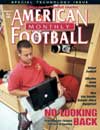AMERICAN FOOTBALL MONTHLY THE #1 RESOURCE FOR FOOTBALL COACHES
Article CategoriesAFM Magazine
|
Going on the offensiveA good software programcan help an offensive coach find his team\\\'s - and his opponent\\\'s - weakspotsby: Joe Hollingsworth © More from this issue The old days of calling the game from the "seat of the pants" are quickly fading into the past. To become more effective, offensive coaches must know their team's tendencies and start looking at the tendencies of their opponent's defense. The first step is for offensive coaches to begin seriously scouting their own offense by using a good scouting software program. The next step is to start scouting the opponent's defense and then to use the information to modify their offensive game plan. The reason scouting software is so important to offensive coaches is obvious. These days, when a defense attacks, it is based on a sophisticated analysis of the opponent's offense. Today's defensive coach prepares his players for what they are going to see on game day and teaches them what adjustments and calls need to be made out on th....The full article can only be seen by subscribers.
|
|
|||||||
| HOME |
MAGAZINE |
SUBSCRIBE | ONLINE COLUMNISTS | COACHING VIDEOS |
Copyright 2025, AmericanFootballMonthly.com
All Rights Reserved





